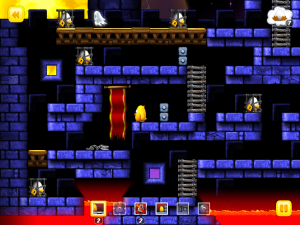Doc Clock: The Toasted Sandwich of Time
OK, here’s another one I’m not finishing immediately. I think I probably could beat it in a day — I’m about halfway through by levels — but I just don’t have the patience right now.
Doc Clock is a physics puzzler/platformer. Despite its time-travel theme, it isn’t in any way about time-travel puzzles. The overall goal involves finding the parts of a time machine so you can travel back to before a mistake you make in the very beginning, and it has a Braid-like rewind mechanic, and that’s it. As we observed in Toki Tori, though, a rewind mechanic doesn’t really need to fit in the fiction or theme; it fits comfortably in the realm of save/load and restart level functions. (Although “Toki Tori” is Japanese for “time bird”, so perhaps earlier iterations of the title fit the rewind into the story? The version I played didn’t really have a story, but I understand earlier versions did.)
Instead, the game seems to be mostly about wacky vehicle customization, except for the first couple of levels, which are about planks: using planks to bridge gaps, rotating them to form inclined planes, attaching them together to form larger planks, etc. Vehicle customization is also about attaching grabbable objects together, and is very fiddly. You can attach components to your time-car at any point and at any angle, so getting that spring on just right so that it propels the vehicle onto a platform above you without overshooting can take multiple little adjustments — and each attempt involves a nontrivial recovery time, even with rewinding. The one problem I seem to have the most is stability: a lot of arrangements tend to flip over on their back in adverse conditions, like accelerating. You can fix this by attaching something heavy (like a sofa or a refrigerator) to the bottom of the vehicle, but that approach has problems of its own.
Anyway, I started this game thinking that it would be lynchpin puzzles, things with an “Aha!” factor, but it turns out to be all tinkering and adjustment and falling onto spikes because the irregular block you put over them is a few pixels away from a stable position. So I’ll get back to it some other day, when I’m in the mood for that sort of thing.
 Comments(1)
Comments(1)